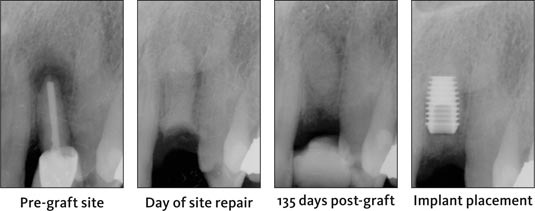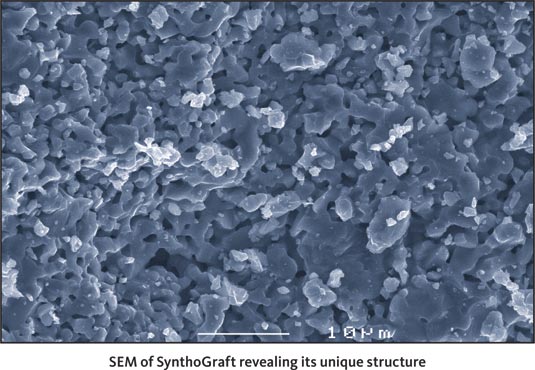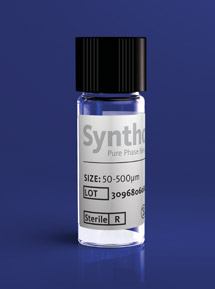![]() SynthoGraft™:
The Next Generation of Regeneration™
SynthoGraft™:
The Next Generation of Regeneration™
![]()
A History of Innovation and Invention
 In 1968, Mr. Thomas Driskell initiated his dental implant and bone regeneration
research. The US Army Medical Research and Development Command’s Dental
Research Division funded the development of a free-standing single tooth
replacement implant that could be placed into a fresh extraction site,
and the development of synthetic bone grafting materials for the repair
of avulsive wounds.
In 1968, Mr. Thomas Driskell initiated his dental implant and bone regeneration
research. The US Army Medical Research and Development Command’s Dental
Research Division funded the development of a free-standing single tooth
replacement implant that could be placed into a fresh extraction site,
and the development of synthetic bone grafting materials for the repair
of avulsive wounds.
His implant research went on to create multiple revolutionary designs, culminating in the Bicon Dental Implant, his magnum opus released in 1985. As for his bone grafting research, that resulted in the invention of beta phase Tricalcium Phosphate (βTCP) in 1971. This was a quantum leap in bioactive materials development. It was designed to resorb while being replaced by normal bone. This original formulation of βTCP was initially marketed as SynthoGraft by Miter, and later by Johnson and Johnson. Miter’s βTCP was made according to the original formulation developed from Driskell’s original research. It was very slightly rich in phosphorous which resulted from the chemical process used to create the material. Thus, the original version of βTCP was not quite stoichiometric.
When this original βTCP was used for sinus grafting and for filling bony defects prior to placing dental implants, it was recommended that the clinician wait a minimum of six months after grafting before placing implants in the grafted site. In reality, however, most clinicians combined Miter’s βTCP with particulate autogenous bone, freeze-dried bone particles, or other supposedly osteogenic bone grafting substances, particularly in larger grafted sites. It was also common to mix the material with saline rather than blood as they did with particulate Hydroxylapatite grafting materials being used at the time. These mixing techniques were disproved in the research conducted by Bicon.
The Next Generation of Regeneration
A new formulation of SynthoGraft was introduced
on September 9, 2005, at the Bicon World Symposium 2005. Substantial reasons exist for the proven
effectiveness of Bicon’s SynthoGraft. Most important is the rate and quality
of bone regeneration as well as the rate of resorption of the graft material
as it is being replaced by the patient’s own bone during the healing process.
Before bringing SynthoGraft back onto the dental market, much effort was
put into creating a stoichiometric product, that is to say, a pure phase
product — the perfect mixture. Recent clinical studies* using the new SynthoGraft
have shown a reduction in the healing time of the grafted site prior to
placing implants. One clinical study has shown sufficient stability at
three months in lateral sinus grafts for the placement of implants.

While several varieties of βTCP are now commercially available, they are not all equal in bone regenerating capability. These differences can profoundly affect the rate and quality of bone regeneration, as well as the rate of resorption of the graft material as it is being replaced by the patients’ own bone during the healing process.

SynthoGraft’s unique structure provides increased stability and its micro-porosity and nano-porosity allow for rapid vascularization and subsequent resorption. SynthoGraft achieves the greatest efficacy when mixed with the patient’s own blood. Other additives, including autogenous bone particles, are not needed or recommended.
Thomas Driskell is still an active participant with the present Bicon team responsible for the recent and ongoing research using SynthoGraft in various applications. When asked how he felt about the long history of his numerous innovations and his continuing contributions to implant dentistry, he replied, “I feel fortunate in having had the opportunity over the years to create a number of new approaches to implant dentistry. Being able to help so many people obtain truly effective and aesthetic long term solutions for their dental problems continues to be exciting!”
* Studies performed at the University of Cartagena, S.A. and Forsyth Institute, Boston, MA.
SynthoGraft™ is a synthetic, biocompatible and resorbable granulate ceramic made of pure phase Beta-Tricalcium Phosphate (Ca3(PO4)2) which is used as a matrix for oral and maxillofacial bone regeneration or augmentation.

